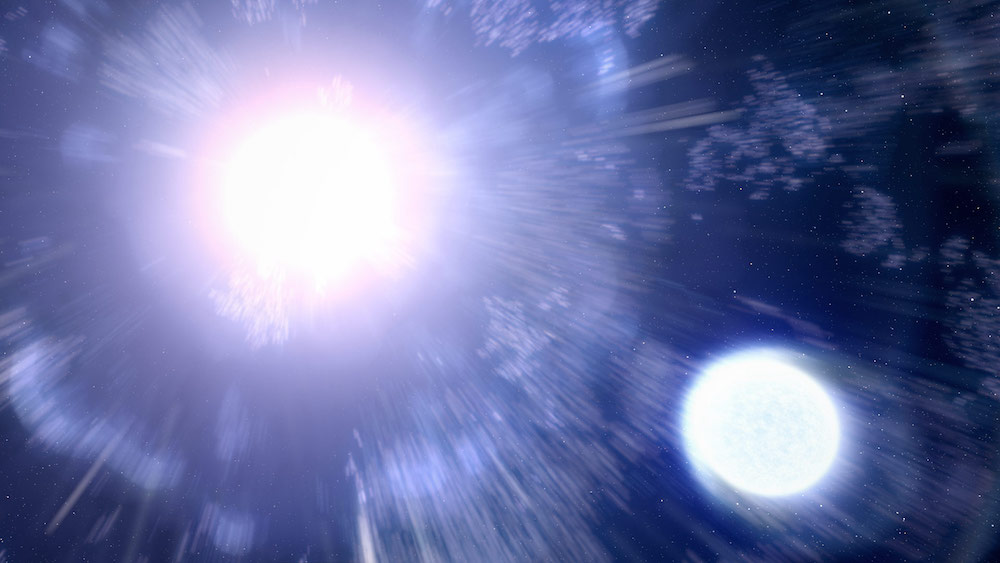Create a free profile to get unlimited access to exclusive videos, sweepstakes, and more!
Supernova alert! Now astronomers have a warning system for when stars go boom!
The clock could start ticking at any moment.

In Oblivion, humanity is attempting to recover from a narrowly won war with an alien species. We survived, but the planet is wrecked and the only hope — at least according to the authorities — is to leave Earth behind. As the movie opens, that’s what we think is happening. In truth, the conflict is ongoing. The space station ferrying humanity off-world is actually an alien craft stealing the last of humanity’s resources before they leave. They’ve even tricked some folks like Jack Harper into helping them. Humanity ultimately prevails, but it was a near thing. If only we had had some advanced warning.
When it comes to actual oblivion, there are few things in the universe more destructive than a supernova, and astronomers have no real way of knowing when they’re going to happen. While supernovae aren’t a cosmic threat to Earth — our star isn’t large enough to enjoy such a flashy end — they do cause incredible carnage when they occur. The trouble is we typically don’t know they’re happening until they’ve already begun. Unless we are very lucky and happen to already be looking at a star when it explodes, we’re likely to miss the opening acts.
Getting our eyes on a supernova before it begins would allow astronomers to gather a complete picture of what happens, and expand our understanding of the cosmos... and now we can. Scientists from Liverpool John Moores University and Université de Montpellier have recently devised a way of detecting supernovae before they happen. Their method was published in the Monthly Notices of the Royal Astronomical Society.
To understand what they’ve done we first need to understand how stars work and how supernovae form. When a star burns fuel in its core, it creates internal pressure which pushes the star to expand. However, the star is also under the influence of gravity, which wants to pull all of the mass into the center. When the star is young or middle aged and actively fusing fuel in its core, those two opposing forces reach a sort of equilibrium which defines the size of the star. And that continues for millions or billions of years, depending on the type of star.
At the end of a star’s life, it’s starts running out of fuel to burn and the core starts to cool, which reduces the internal pressure. It also starts to accumulate material around itself, almost as if it’s hungrily gobbling up whatever it can find before the end. One last meal. This accumulation of material is important, and we’ll come back to it later.
Meanwhile, gravity is still pushing the star toward its center. If you’ve ever seen a soda can in a vacuum chamber you know what’s about to happen. Without the internal pressure, gravity overwhelms the star, and it rapidly collapses in on itself. The force of that collapse creates a shockwave which blows parts of the star apart in a brilliant explosion. That’s a supernova.
If the star is even larger, at least ten times the mass of the Sun, the collapse will continue, leaving behind a black hole. Supernovae are among the most interesting phenomena in the universe but, until now, they’ve been difficult to study in real time. There was no telling when they would go boom.
Astronomers have been waiting for years for Betelgeuse to finally give up the ghost. The star, which appears in the night sky as the left shoulder of Orion, is expected to go supernova any day now. Of course, any day now in astronomical terms could be tomorrow or it could be thousands of years from now. When it finally does blow its top, the explosion will be so bright you’ll be able to see it in the daytime.
We still can’t predict precisely when Betelgeuse, or any other star, will explode, but the process in the Royal Astronomical Society paper provides an early warning system. Researchers found that massive stars near the ends of their lives shift into a red supergiant phase. At that time, they start accumulating that material we talked about earlier. So much material gets pulled toward the star that it blocks the star’s light from reaching us. During this phase, the star can become something like a hundred times dimmer and could get so dim that in the days leading up to the explosion we wouldn’t be able to see it at all.
These cocoons of material envelope the star in preparation for its final metamorphosis. The researchers looked at historical images of stars before they went supernova and found that they didn’t see this phase or accumulation a year before they blew. That means that it happens months before the explosion at most. It provides a window of time during which we can reasonably expect a star to pop.
Having a timeline for a star’s end of life process could allow astronomers to plan in advance for an upcoming supernova explosion. Rather than racing to capture images after the fact, we could point our telescopes days or months before the explosion happens and capture every moment of the process.
When Betelgeuse finally does rip itself apart, there’s a good chance we’ll get a front row seat. All we have to do is wait for the lights to go down.



























